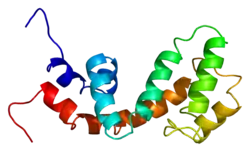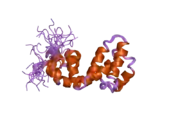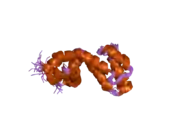| RGS18 | |||||||||||||||||||||||||||||||||||||||||||||||||||
|---|---|---|---|---|---|---|---|---|---|---|---|---|---|---|---|---|---|---|---|---|---|---|---|---|---|---|---|---|---|---|---|---|---|---|---|---|---|---|---|---|---|---|---|---|---|---|---|---|---|---|---|
 | |||||||||||||||||||||||||||||||||||||||||||||||||||
| |||||||||||||||||||||||||||||||||||||||||||||||||||
| Identifiers | |||||||||||||||||||||||||||||||||||||||||||||||||||
| Aliases | RGS18, RGS13, regulator of G-protein signaling 18, regulator of G protein signaling 18 | ||||||||||||||||||||||||||||||||||||||||||||||||||
| External IDs | OMIM: 607192 MGI: 1927498 HomoloGene: 11281 GeneCards: RGS18 | ||||||||||||||||||||||||||||||||||||||||||||||||||
| |||||||||||||||||||||||||||||||||||||||||||||||||||
| |||||||||||||||||||||||||||||||||||||||||||||||||||
| |||||||||||||||||||||||||||||||||||||||||||||||||||
| |||||||||||||||||||||||||||||||||||||||||||||||||||
| |||||||||||||||||||||||||||||||||||||||||||||||||||
| Wikidata | |||||||||||||||||||||||||||||||||||||||||||||||||||
| |||||||||||||||||||||||||||||||||||||||||||||||||||
Regulator of G-protein signaling 18 is a protein that in humans is encoded by the RGS18 gene.[5][6]
Function
This gene encodes a member of the regulator of G-protein signaling family. This protein contains a conserved 120 amino acid motif called the RGS domain. The protein attenuates the signaling activity of G-proteins by binding to activated, GTP-bound G alpha subunits and acting as a GTPase activating protein (GAP), increasing the rate of conversion of the GTP to GDP. This hydrolysis allows the G alpha subunits to bind G beta/gamma subunit heterodimers, forming inactive G-protein heterotrimers, thereby terminating the signal. Alternate transcriptional splice variants of this gene have been observed but have not been thoroughly characterized.[6]
Clinical significance
Several RGS18 alleles that result in reduced RGS18 expression are associated with the development of atherosclerosis.[7] Two single nucleotide polymorphisms in the RGS18 gene that interfere with binding of GATA1 and NFE2 transcription factors result in decreased expression of RGS18. RSG18 Knockout mice display an exaggerated platelet reactivity which in turn increases risk of developing atherosclerosis. A minor allele of RSG18 is associated with the appearance of thrombotic phenomena in a cohort of European-American and African-American patients.[7]
Interactions
References
- 1 2 3 GRCh38: Ensembl release 89: ENSG00000150681 - Ensembl, May 2017
- 1 2 3 GRCm38: Ensembl release 89: ENSMUSG00000026357 - Ensembl, May 2017
- ↑ "Human PubMed Reference:". National Center for Biotechnology Information, U.S. National Library of Medicine.
- ↑ "Mouse PubMed Reference:". National Center for Biotechnology Information, U.S. National Library of Medicine.
- ↑ Park IK, Klug CA, Li K, Jerabek L, Li L, Nanamori M, et al. (January 2001). "Molecular cloning and characterization of a novel regulator of G-protein signaling from mouse hematopoietic stem cells". The Journal of Biological Chemistry. 276 (2): 915–923. doi:10.1074/jbc.M005947200. PMID 11042171.
- 1 2 "Entrez Gene: RGS18 regulator of G-protein signalling 18".
- 1 2 Keramati AR, Chen MH, Rodriguez BA, Yanek LR, Bhan A, Gaynor BJ, et al. (NHLBI Trans-Omics for Precision (TOPMed) Consortium) (June 2021). "Genome sequencing unveils a regulatory landscape of platelet reactivity". Nature Communications. 12 (1): 3626. Bibcode:2021NatCo..12.3626K. doi:10.1038/s41467-021-23470-9. PMC 8206369. PMID 34131117.
- ↑ Yowe D, Weich N, Prabhudas M, Poisson L, Errada P, Kapeller R, et al. (October 2001). "RGS18 is a myeloerythroid lineage-specific regulator of G-protein-signalling molecule highly expressed in megakaryocytes". The Biochemical Journal. 359 (Pt 1): 109–118. doi:10.1042/bj3590109. PMC 1222126. PMID 11563974.
- ↑ Gagnon AW, Murray DL, Leadley RJ (July 2002). "Cloning and characterization of a novel regulator of G protein signalling in human platelets". Cellular Signalling. 14 (7): 595–606. doi:10.1016/S0898-6568(02)00012-8. PMID 11955952.
Further reading
- Nagata Y, Oda M, Nakata H, Shozaki Y, Kozasa T, Todokoro K (May 2001). "A novel regulator of G-protein signaling bearing GAP activity for Galphai and Galphaq in megakaryocytes". Blood. 97 (10): 3051–3060. doi:10.1182/blood.V97.10.3051. PMID 11342430.
- Yowe D, Weich N, Prabhudas M, Poisson L, Errada P, Kapeller R, et al. (October 2001). "RGS18 is a myeloerythroid lineage-specific regulator of G-protein-signalling molecule highly expressed in megakaryocytes". The Biochemical Journal. 359 (Pt 1): 109–118. doi:10.1042/bj3590109. PMC 1222126. PMID 11563974.
- Sierra DA, Gilbert DJ, Householder D, Grishin NV, Yu K, Ukidwe P, et al. (February 2002). "Evolution of the regulators of G-protein signaling multigene family in mouse and human". Genomics. 79 (2): 177–185. doi:10.1006/geno.2002.6693. PMID 11829488. S2CID 16065132.
- Gagnon AW, Murray DL, Leadley RJ (July 2002). "Cloning and characterization of a novel regulator of G protein signalling in human platelets". Cellular Signalling. 14 (7): 595–606. doi:10.1016/S0898-6568(02)00012-8. PMID 11955952.
- Gevaert K, Goethals M, Martens L, Van Damme J, Staes A, Thomas GR, Vandekerckhove J (May 2003). "Exploring proteomes and analyzing protein processing by mass spectrometric identification of sorted N-terminal peptides". Nature Biotechnology. 21 (5): 566–569. doi:10.1038/nbt810. PMID 12665801. S2CID 23783563.
- Larminie C, Murdock P, Walhin JP, Duckworth M, Blumer KJ, Scheideler MA, Garnier M (March 2004). "Selective expression of regulators of G-protein signaling (RGS) in the human central nervous system". Brain Research. Molecular Brain Research. 122 (1): 24–34. doi:10.1016/j.molbrainres.2003.11.014. PMID 14992813.







